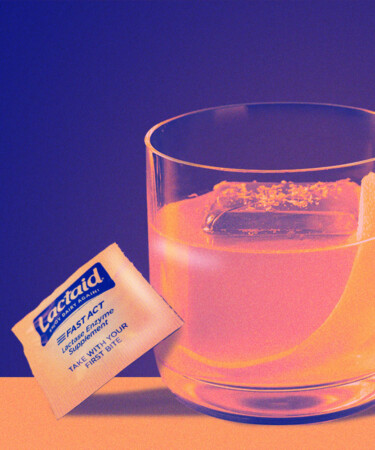Beloved for their creamy mouthfeel and succulent flavor profiles, milk punches are finally popping up more and more frequently on menus despite their nearly 400-year-old history. While traditionally made with milk, Earl Grey tea, spices, and brown spirits, modern milk punches are being made with a variety of spirits and ingredients, piquing the interest of bartenders and thirsty drinkers alike.
Milk punches can be made in two styles, both of which typically contain whole milk: the New Orleans style, which can be identified by its creamy appearance, or the English style, also known as a Clarified Milk Punch, which is strained and clarified to achieve a clear appearance while maintaining a creamy mouthfeel and taste. The reemergence of the latter — with their appearance being the opposite of, well, milky — has given rise to questions regarding their safety for individuals with a lactose intolerance. It doesn’t look like milk, so it can’t actually be milk, right? To find out if you can drink clarified milk punch without needing to pop a Lactaid, we tapped Kelly Verardo, bar programs director for the Altamarea Group, for more information.
Before it can be deemed safe for everyone to drink, it’s important to first understand what milk punch actually contains. The clarified variety is made by blending a base liquid — Earl Grey tea was traditionally used, but today, water and even oleo saccharum are utilized to impart more flavor — with a spirit. Once the spirit and the base are well-combined and infused with sugars, spices, and citrus, cooled curdled milk is added, and then the entire mixture is chilled overnight in the refrigerator. Verardo explains that after this resting period, the liquid is strained through a cheesecloth of coffee filter to remove smaller pieces of milk solids, producing a fully clear beverage.
“The beauty of milk punch is that you get this weighty, creamy silkiness on your palate that would be difficult to achieve without adding any milk, yet you still have a clear beverage,” she explains. That said, this means that despite their visual appearance, milk punches still contain lactose as the milk’s protein molecules do not break down in the clarifying process.
“Even though milk solids are being removed during the clarifying process, lactose is water- and sugar-soluble, meaning despite the fact that the milk appearance is removed, the lactose proteins still remain,” Verardo says.
Verardo says that a batch of clarified milk punch typically requires roughly one liter of milk for every two liters of spirit added, which is a considerable amount of lactose to process for those with an intolerance. But with the influx of dairy-free milk substitutes hitting the shelves, a sensitive stomach doesn’t need to hold you back: Verdaro says that people with a lactose intolerance can definitely still enjoy a milk punch, but that they should make one for themselves at home using non-dairy milk.
While non-dairy milks may be harder to curdle than regular dairy milk, Verardo explains that it’s still possible. “Soy milk is a popular recommendation as it’s the closest in composition to whole milk, but coconut milk is also very popular,” she says. “It’s higher in fat and lower in protein so a high temperature is needed to get it to curdle, so I would suggest blending it with nut milk or soy milk.” Additionally, lactose-free milk brands like Rockey’s are gaining traction with dairy-free consumers and mixologists alike, with some bars choosing to use this beverage in place of regular milk when creating their clarified milks.
Above all, it’s important to consider your health while drinking. As Verardo suggests, making your own non-dairy version at home is your safest bet, and never just assume that a bar or restaurant’s milk punch will be safe to drink.
“I would assume if you are at a restaurant and they have a milk punch on their menu, that it’s been made with whole milk unless they specify else-wise,” she says. “As such, if you’re interested in ordering one, you should ask the bartender what they make there and be sure to carry a Lactaid just in case.”
